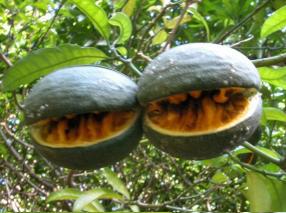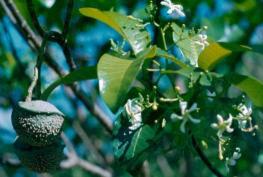Tabernaemontana ventricosa
Tabernaemontana ventricosa Hochst. ex. A.DC.
Family: Apocynaceae
Common names: forest toad tree (Eng; bospaddaboom (Afr.); uKhamamasane (Zulu)
SA Tree No: 645
Introduction
This tree, with its unusual fruits, is excellent for gardeners wanting to bring nature back into their garden — it attracts birds, insects and small mammals.

Description
Description
This small to medium-sized tree can reach a maximum height of 15 m, but averages between 4 and 8 m. It has a single, slender, straight trunk with smooth grayish-brown bark. The tree is low-branching with smooth, dark-green young branches turning a pale-brown when mature.

The flowers are salver-shaped, white and sweet smelling (October to December) The fruits are pods, usually two joined at the base. They are dark-green and smooth, sometimes with wrinkles and light-green speckles or markings. They split open to reveal fleshy orange pulp with embedded seeds in June to August.

Distribution and habitat
Distribution description
This tree grows in riverine forests and forest understoreys in the coastal areas of KwaZulu-Natal. It is also found in Zimbabwe and Mozambique.
Derivation of name and historical aspects
History
The genus Tabernaemontana can be found throughout tropical America, tropical and subtropical Africa, as well as Madagascar. The genus consists of 25 species of which 2 are found in South Africa. The second species is Tabernaemontana elegans known commonly as the toad tree. The genus name Tabernaemontana is taken from the name of a 16th-Century physician and herbalist, Jacob Theodore. He latinized his name to Tabernaemontanus. Ventricosa means to having a swelling on one side, being pot-bellied and probably refers to the shape of the fruits.
Ecology
Ecology
Animals such as monkeys and birds eat the fruit. The leaves are browsed by game and the sweet-smelling flowers attract various insects.
Uses
Use
The bark of this tree is said to be used for bringing down a fever, and the sap can be used to treat wounds and sore eyes. The pulp of the ripe fruit is edible. The latex found in the tree is used by some people as birdlime. The wood is suitable for planks and is said to be insect-proof.
Growing Tabernaemontana ventricosa
Grow
This small to medium-sized evergreen tree with its dark-green leaves and large dark-green fruit will make an attractive addition to your garden.

The tree prefers full to semi-shade, but can withstand a certain amount of sunlight. It requires a moderate amount of water. This tree is frost-sensitive, preferring more tropical areas with mild winters. It can easily be grown from seed and grows relatively fast.
The other tree in this genus, Tabernaemontana elegans (toad tree), is also an excellent garden subject that will attract many small creatures into your garden. This small deciduous tree ranges between 3 and 10 m in height. It is semi- frost resistant and can grow in full sun to semi-shade. It requires a moderate amount of water. It has attractive dark-green glossy leaves and rough, deeply fissured, corky bark. The flowers are also white and sweetly scented, attracting various insects. It flowers from September to March. The edible fruits, are also paired, but covered in light brown warts resembling a toad's skin, hence the common name. They occur from February to August.
References
- Schmidt, E., Lötter, M. & McCleland, W. 2002. Trees and shrubs of Mpumalanga and Kruger National Park. Jacana, Johannesburg .
- Van Wyk, B. & Van Wyk, P. 1997. Field guide to trees of southern Africa. Struik, Cape Town .
- Pooley, E. 1993. The complete field guide to trees of Natal, Zululand & Transkei. Natal Flora Publications Trust, Durban
Credits
Lou-Nita Le Roux
Lowveld National Botanical Garden
January 2005
Plant Attributes:
Plant Type: Shrub, Tree
SA Distribution: KwaZulu-Natal
Soil type: Sandy, Loam
Flowering season: Early Summer
PH: Acid, Neutral
Flower colour: White
Aspect: Shade, Morning Sun (Semi Shade), Afternoon Sun (Semi Shade)
Gardening skill: Average
Special Features:
Horticultural zones








Rate this article
Article well written and informative
Rate this plant
Is this an interesting plant?
Login to add your Comment
Back to topNot registered yet? Click here to register.